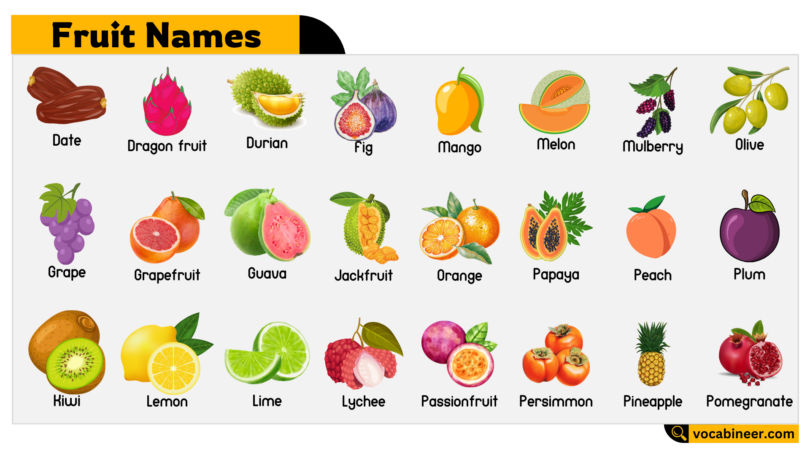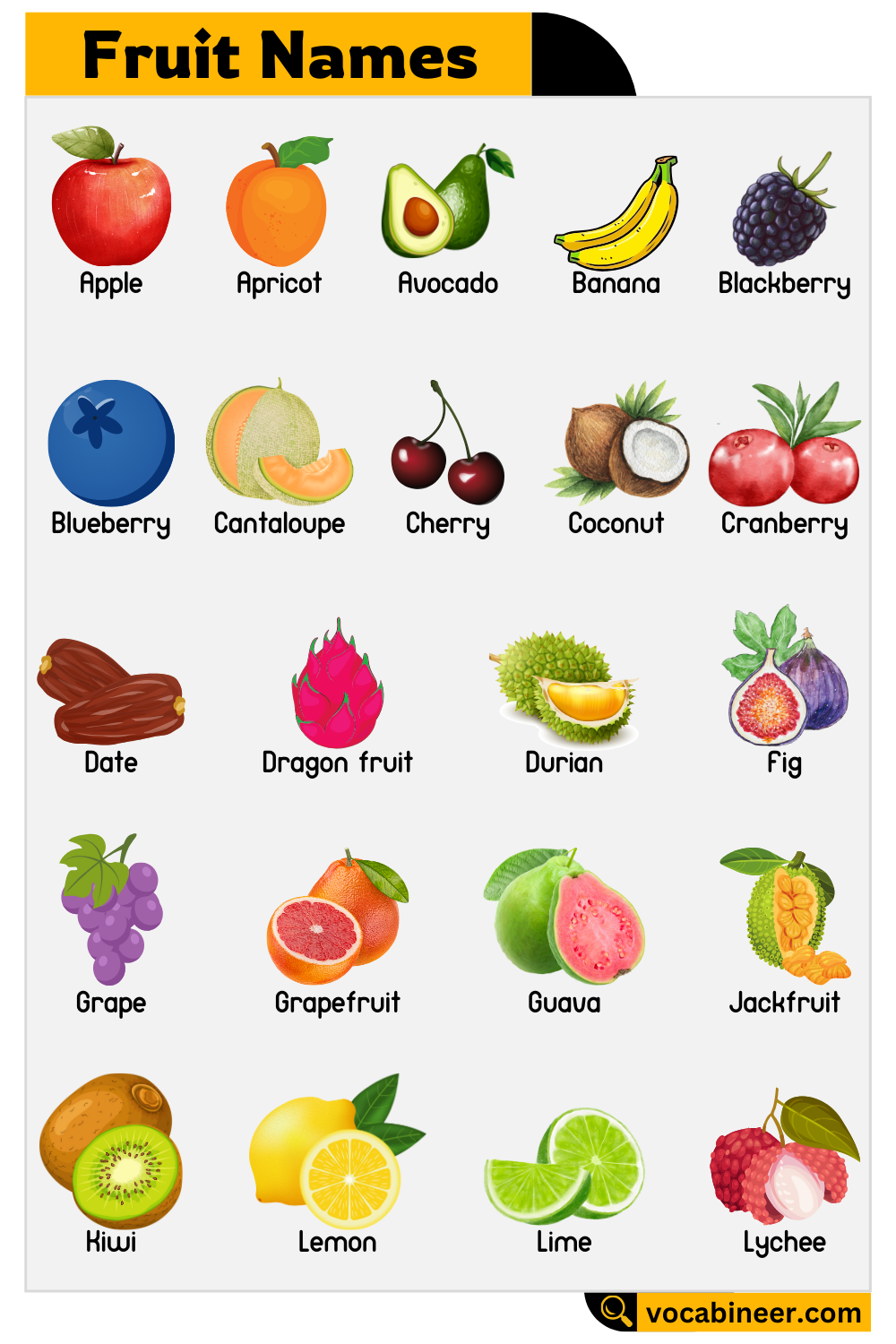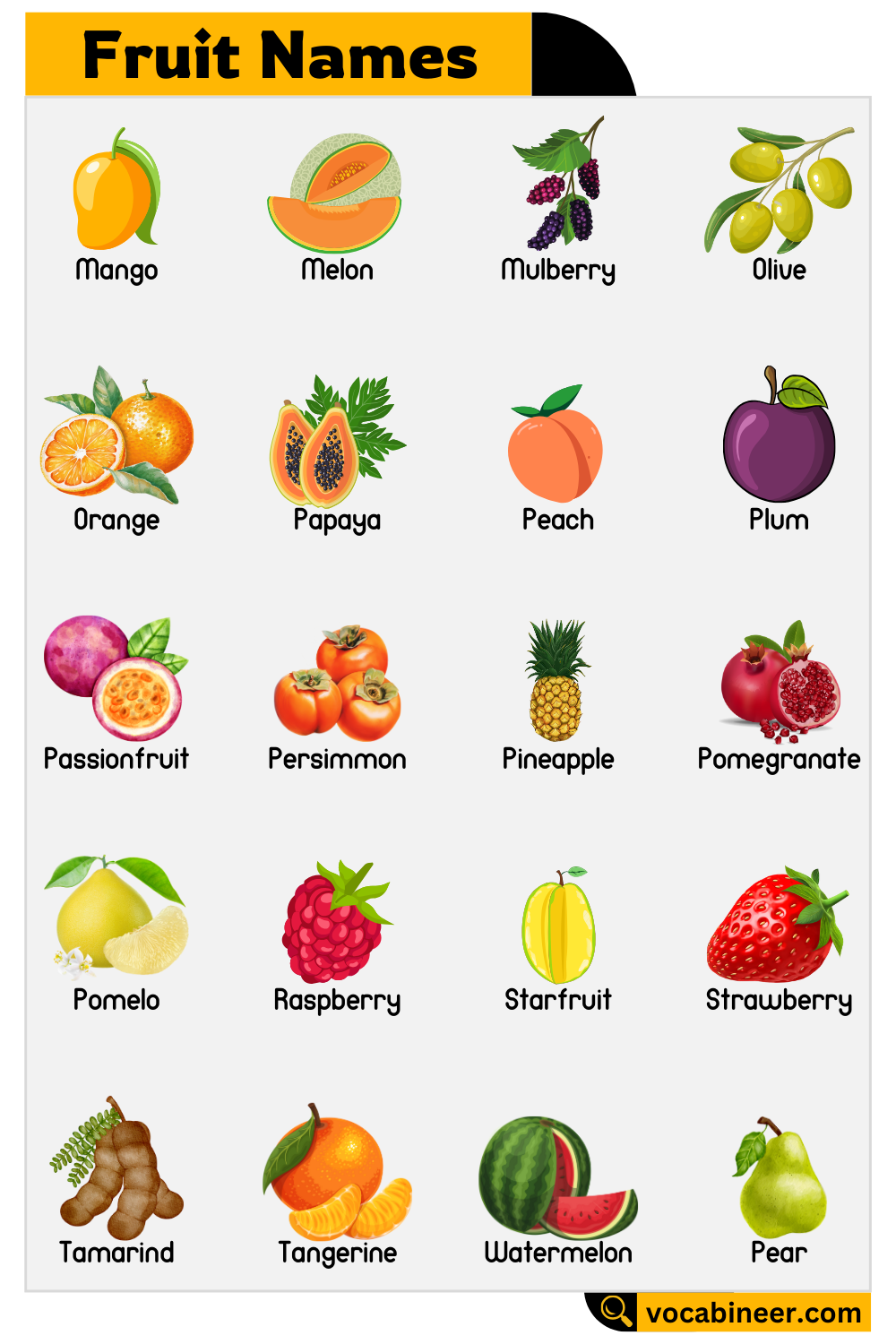Learning fruit names in English is important for expanding your vocabulary, especially if you’re a beginner or intermediate learner. Fruits are everyday items we encounter in markets, kitchens, and conversations, making them essential vocabulary for daily interactions. This blog post will help you master fruit vocabulary using clear descriptions and visual associations, addressing common difficulties learners face when memorizing new words. Ready to boost your English skills? Visit our Picture Vocabulary category to keep improving your vocabulary through engaging visuals.
In This Page
Common Fruits Vocabulary
Familiar Fruits
These fruits are common in many countries and easy to recognize.
- Apple: Crunchy, sweet fruit often eaten fresh or in desserts.
- Banana: A soft, sweet, yellow fruit rich in potassium.
- Orange: Citrus fruit known for its juicy segments and Vitamin C.
- Strawberry: Red, juicy fruit often eaten fresh or in jams.
- Grape: Small, round fruit commonly used to make juice or wine.
Tropical Fruits
These fruits typically grow in warm climates and have unique tastes.
- Mango: Sweet, tropical fruit with a juicy flesh loved worldwide.
- Papaya: Soft, sweet fruit rich in digestive enzymes.
- Pineapple: Tropical fruit with a tough exterior and sweet, juicy interior.
- Coconut: Fruit known for its refreshing water and nutritious white flesh.
- Avocado: Creamy fruit widely used in savory dishes and salads.
Berries Names
Small, juicy fruits often packed with vitamins.
- Blueberry: Sweet and nutritious fruit known for antioxidant properties.
- Blackberry: Juicy, dark-colored berry often used in desserts.
- Raspberry: Bright, tart fruit commonly eaten fresh or in sauces.
- Cranberry: Tart berry often consumed as juice or sauce.
- Mulberry: Sweet berry known for its dark purple or red color.
Citrus Fruits Names
Refreshing fruits known for their juicy segments and tangy flavors.
- Lemon: Sour, yellow fruit often used to flavor food and drinks.
- Lime: Tart, green fruit commonly used in beverages and cooking.
- Grapefruit: Citrus fruit with a slightly bitter taste, usually eaten fresh.
- Tangerine: Sweet citrus fruit that’s easy to peel and segment.
- Pomelo: Large citrus fruit with a mild, sweet flavor similar to grapefruit.
Exotic Fruits
Less common fruits with unique flavors and appearances.
- Dragonfruit: Brightly colored fruit with mild, sweet taste.
- Durian: Fruit known for its strong smell but rich, creamy taste.
- Lychee: Small fruit with sweet, fragrant flesh.
- Passionfruit: Juicy fruit with a sweet-tart flavor, eaten fresh or as juice.
- Starfruit: Star-shaped fruit that’s crisp, sweet, and tangy.
Stone Fruits
Fruits containing a large, hard seed (stone) in the center.
- Peach: Juicy, sweet fruit often eaten fresh or cooked.
- Plum: Soft, juicy fruit with a sweet or tart taste.
- Apricot: Small, sweet fruit known for its soft, velvety skin.
- Cherry: Small, round, red or black fruit eaten fresh or used in cooking.
- Nectarine: Smooth-skinned fruit similar in taste and texture to peaches.
Other Interesting Fruits
Distinctive fruits with diverse culinary uses.
- Pomegranate: Fruit with sweet, juicy seeds, eaten fresh or juiced.
- Persimmon: Sweet fruit often eaten ripe as a snack or in desserts.
- Fig: Soft, sweet fruit enjoyed fresh or dried.
- Date: Sweet fruit usually dried and eaten as a nutritious snack.
- Jackfruit: Large fruit known for its sweet, fibrous flesh used in both sweet and savory dishes.
- Melon: Juicy fruit enjoyed fresh, especially in warmer seasons.
- Watermelon: Refreshing fruit known for its sweet, hydrating flesh.
- Olive: Small fruit primarily eaten pickled or used for oil.
- Cantaloupe: Sweet melon known for its fragrant, juicy flesh.
- Tamarind: Fruit with tangy pulp commonly used in cooking.
Download Your High-Quality Fruit Vocabulary Infographic Now!
Enhance your English vocabulary practice effortlessly with our colorful and engaging Fruit Vocabulary Infographic. Perfect for beginners and intermediate learners, it’s designed to help you quickly memorize and recognize fruit names visually. Download, print, and start learning today!
Conclusion
Practicing these fruit names regularly will help you speak English more confidently. Which fruits from the list are your favorites? Comment below and share your thoughts! Don’t forget to download your free “Printable Fruit Vocabulary Infographic,” a helpful resource to memorize and practice fruit names easily.








